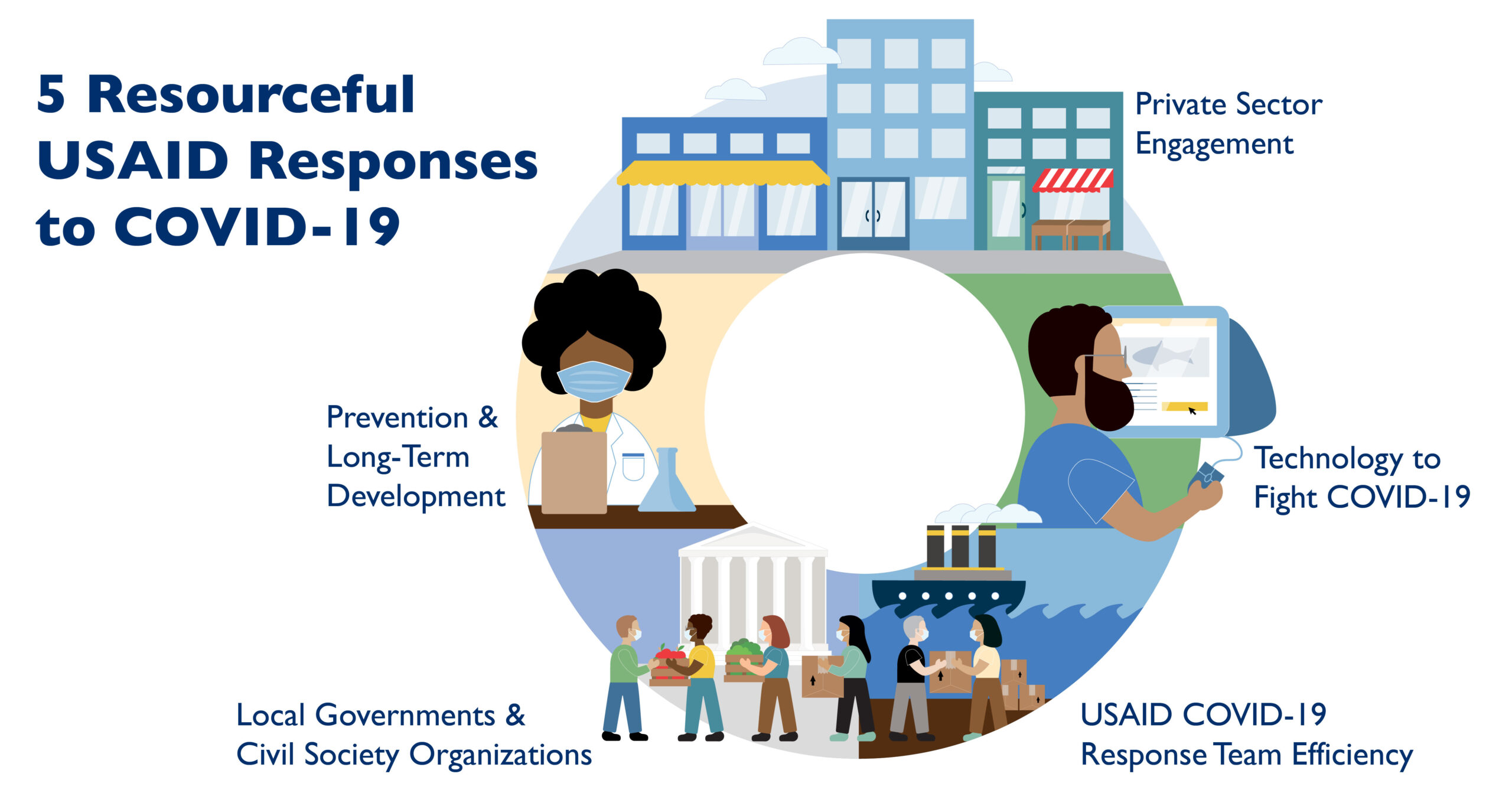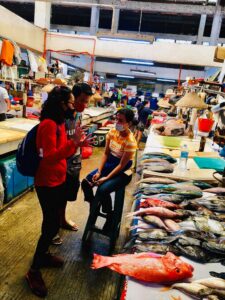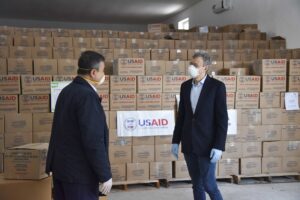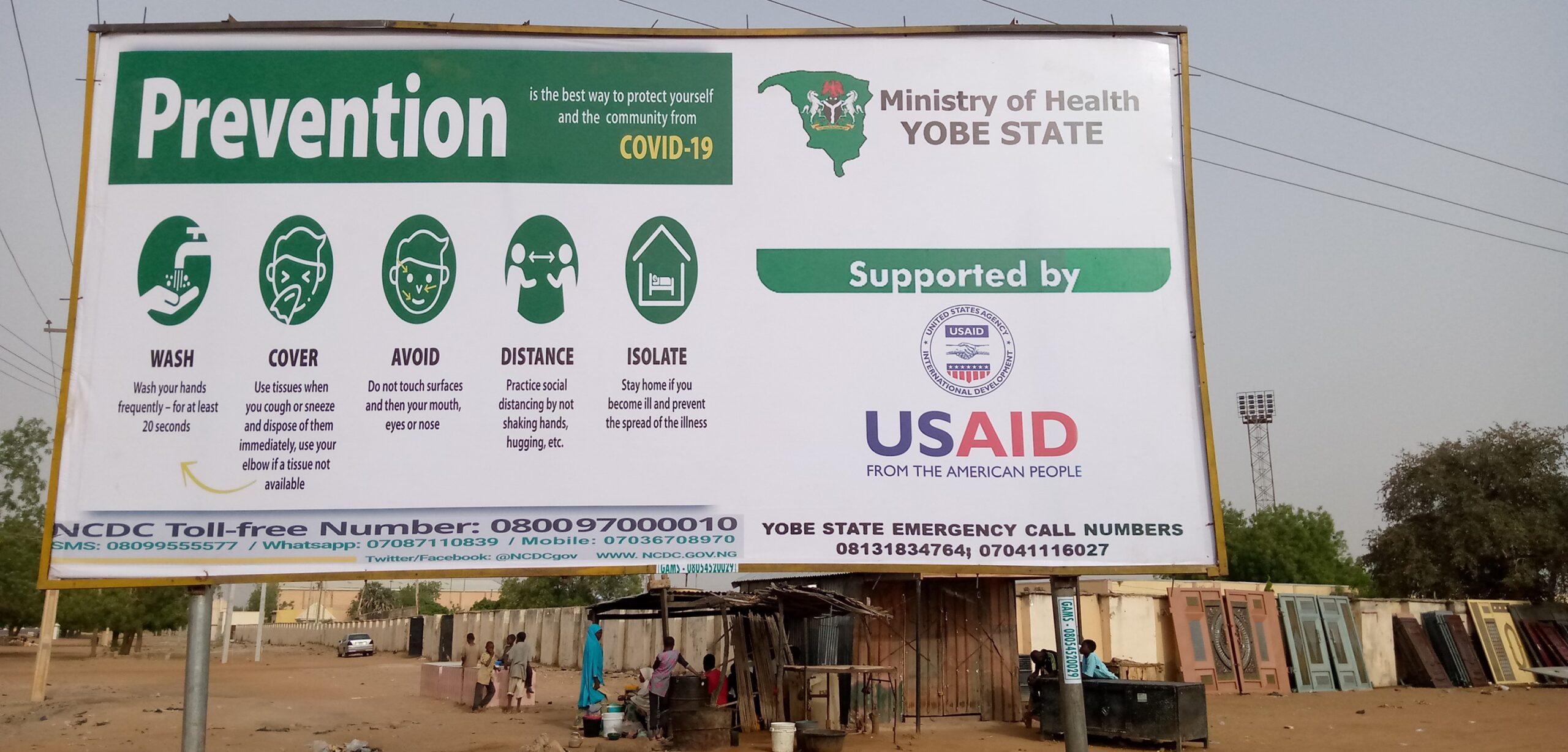<< Back to Media
Five Resourceful USAID Responses to Covid-19
November 5, 2020
The COVID-19 pandemic has forced nearly every person and entity — workers, families, companies, and governments — to think and act in new ways. To ensure its life-saving mission with partner countries continues around the world, the U.S. Agency for International Development (USAID) is responding to the pandemic in rapid, collaborative, and flexible ways. The Agency has done more than just commit funds (over $1 billion to date) to combat COVID-19 by providing public health education, protecting healthcare facilities, and increasing laboratory, disease-surveillance, and rapid-response capacity in over 120 countries. It has invested each dollar with deliberate forethought.
The twin aims of USAID’s response to COVID-19 are to save lives and mitigate the destabilizing secondary impacts, especially the loss of jobs and businesses. Underlying the decisions designed to protect the global economy and global health is the concurrent goal of preserving the health of American citizens, U.S. trade partnerships, and U.S. national security — all important reasons why the United States provides foreign assistance. Global health security operates on the basis that an infectious disease anywhere is a threat everywhere.
Here are 5 resourceful ways USAID is responding to the COVID-19 pandemic — and why it matters.

1. Private Sector Engagement
Through USAID’s Private Sector Engagement Policy (PSE), the Agency can achieve better humanitarian and development outcomes — including slowing the spread of COVID-19 — by partnering with corporations and businesses.
In Vietnam, for example, USAID is helping to address gaps in the PPE supply chain, the personal protective equipment worn by health care workers to keep them safe from contracting the virus. USAID LinkSME helps Vietnamese manufacturers to produce medical PPE and connects product suppliers to U.S. distributors. As a result, USAID LinkSME is helping to save the lives of U.S. healthcare workers and patients while promoting private sector-led growth in Vietnam and advancing the United States Indo-Pacific vision of improved trade and competitiveness.
USAID is also strengthening Vietnam’s private sector recovery by enhancing access to finance for businesses.
2. Technology to Fight COVID-19

Jerrydith Alpuerto talks to Fish Tiangge partner vendors in a public market in Dumaguete. Photos by Rizza Mae Beronio for USAID Fish Right.
In the Philippines, USAID has adapted its Fish Right project, Fish Tiangge, to also serve as an online platform that allows local fisherfolk to safely sell to consumers while under quarantine. In November 2018, USAID launched the $25 million project to improve marine biodiversity, strengthen fish management and governance, and increase the number and weight of fish in the Calamianes Islands, the Visayan Sea, and the South Negros region of the Philippines. Now, thanks to USAID’s rapid action, more than 300,000 Filipino households can purchase fresh fish directly from over 6,000 fish sellers on the online market — including bicycle delivery. The novel mobile fish market has initiated a sustainable, nationwide online supply chain of safe, legally-sourced seafood.
“By connecting fishers and consumers online, the U.S. government is helping to protect fisherfolk income and prevent a food crisis, while ensuring that conservation measures are not compromised in areas that are hard-hit by COVID-19,” Ambassador Sung Kim said in a USAID press release on May 12, 2020. “We will continue to work with local partners to help Filipinos manage the impacts of the COVID-19 pandemic while protecting the Philippines’ marine environment.”
This matters to an island nation where more than half the population relies on the fishing industry for their livelihood. The action also supports the U.S. vision for a free and open Indo-Pacific focused on creating open and transparent markets to unlock private enterprise-led growth; advancing citizen-responsive governance that adheres to a rules-based order; and building a resilient network of security partners capable of addressing shared threats.
USAID has also provided its staff and partners with a guide on how to use novel digital tools and approaches to monitor progress, collect data, and track indicators. This supports the Agency’s continued effort to protect the health and safety of its staff and partners and aligns with USAID’s new Digital Strategy.
3. USAID COVID-19 Response Team Efficiency
USAID developed an action plan for all its missions to maximize existing programs to execute its COVID-19 response. The plan breaks down actions that can be done right away and emphasizes lessons learned from the Ebola outbreak.
One quick adaptation of an existing USAID project took place in Timor-Leste in March 2020. Through the USAID Customs Reform Project (CRP) in Dili, the Mission partnered with the Timor-Leste Customs Authority to create a list of 34 critical COVID-related medical supplies and then fast-tracked the customs clearance of those items from ship to shore in record time. Since the list was developed in March, Timor-Leste has cleared more that 25,000 kilograms of critical medical supplies needed in the fight against the virus.
“We’re grateful to the United States for this key support,” said Customs Authority Director General Jose Antonio Fatima Abilio in a USAID press release. “When the CRP approached us with the idea to create a fast-track clearance list for COVID-19 supplies, we quickly recognized how valuable this would be to helping fight the disease in Timor-Leste.”
And back in Vietnam, Healthy Markets, an existing USAID program that works to end the country’s HIV epidemic, ran an online campaign called “Stay home, HIV self-test” allowing people to order an HIV self-test kit by phone, text, or online. The adaptive strategy ensures continued access to HIV testing and antiretroviral therapy during the COVID-19 pandemic in Vietnam; at least 800 kits were delivered in April 2020.
USAID has also provided its staff and partners with a guide on how to use novel digital tools and approaches to monitor progress, collect data, and track indicators. This supports the Agency’s continued effort to protect the health and safety of its staff and partners and aligns with USAID’s new Digital Strategy.
4. Local Governments and Civil Society Organizations
Due to COVID-19 quarantine measures and other safety precautions, transportation routes around the world are closed and supply chains disrupted. That means many local governments and local civil society organizations are in charge of protecting their own health and economies. To ensure successful outcomes and build long-term resilience in communities, USAID is working directly with local governments and strengthening the capacity of local civil society organizations. Here’s a few notable examples from Central Asia.

U.S. Amb. to Uzbekistan Daniel Rosenblum and Nozimjon Muminov, Executive Director, Soglom Avlod Uchun, handing over USAID’s food assistance to Uzbekistan. Photo courtesy of USAID, April 16, 2020.
In the Republic of Uzbekistan, USAID is collaborating with Soglom Avlod Uchun, a local Uzbek charity, and the American nonprofit organization The Resource & Policy Exchange to deliver nearly 300,000 lbs of food assistance to more than 35,000 of the most vulnerable citizens. The donation will reach Uzbeks residing in more than 144 health and social protection facilities, including many that are also providing COVID-related quarantine services to patients in long-term health care facilities, orphanages, and mental health facilities. Soglom Avlod Uchun supports women and children’s health care as well as other vulnerable groups in the country.
USAID is supporting large families from vulnerable groups in the Kyrgyz Republic with food assistance through a USAID-backed public association, Shoola-Kol. At-risk Kyrgyz families were unable to stock up with food supplies before pandemic quarantine measures were put in place — and then many lost their jobs and income. Working through an organization that already receives funding through the USAID-funded Partnership for Innovation Program, Shoola-Kol could deliver USAID food assistance to at-risk families in their communities.
In both of these USAID COVID-19 responses — and many more in the region — USAID advances the U.S. Central Asia Strategy, “which supports and strengthens the sovereignty and independence of the Central Asian States, individually and as a group; encourages regional connectivity between Central Asia and Afghanistan; promotes rule of law and respect for human rights; and promotes U.S. investment in and development of Central Asia — to foster greater regional stability and prosperity.”

U.S. new funding for Nigeria for prevention and mitigation of COVID-19 has reached $21.4 million. Photo: USAID Flikr, uploaded April 10, 2020.
5. Prevention and Long-Term Development
The USAID COVID-19 response in Bangladesh illustrates the Agency’s eye toward prevention and sustained resilience. USAID and the U.S. Centers for Disease Control and Prevention (CDC) — a scientific and public health partner with Bangladesh for over 50 years — have jointly contributed over $22 million for Bangladesh’s ongoing efforts in the long-term pandemic fight.
USAID and the CDC have taken specific COVID-related actions in partnership with the Bangladesh government, its health ministries, and universities:
- Strengthen the country’s laboratory capacity by embedding and training technical staff.
- Conduct surveillance to identify and track individuals infected by COVID-19 and the people they have been in contact with to prevent further spread of the disease and to foster data driven-decision-making.
- Help develop national guidelines on infection prevention and control.
- Help develop guidelines to train more than 1,900 health professionals on COVID-19 management, infection control, and prevention.
- Develop an electronic logistics management information tool to track and manage the commodities needed for COVID-19 prevention.
- Create an online training course on COVID-19 for Bangladeshi doctors.
Working with local government authorities, focusing on prevention and long-term development, making use of technological advances, and maximizing efficiency through collaboration with other U.S. agencies and the private sector all demonstrate USAID’s flexible and adaptive response to rapidly changing needs with its partner countries around the world. And in these few examples above, as in all its programming across sectors and regions, USAID has taken into account vulnerable populations — women, children, and persons with disabilities — in its COVID-19 responses.
The United States has made more than $1billion available to fight COVID-19 around the world.
USAID is making the most of each dollar.
Author: Mary Jane Maxwell, Lead Consultant at Washington Business Dynamics
…..
